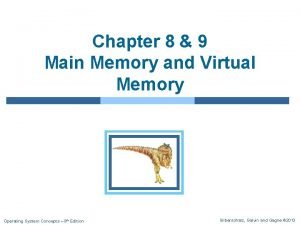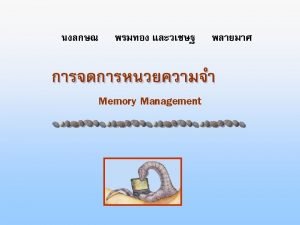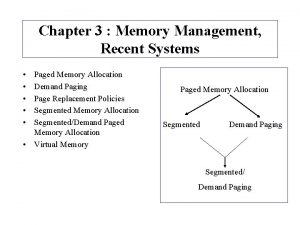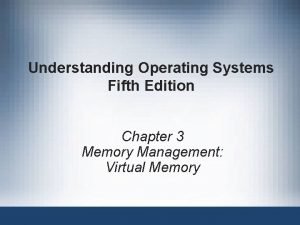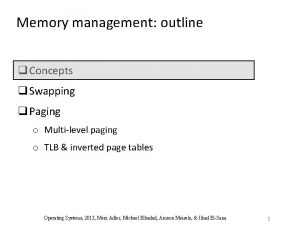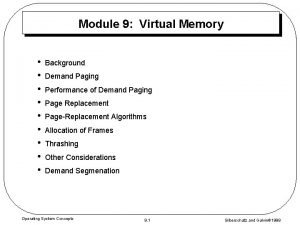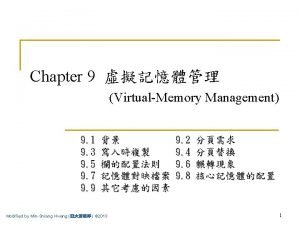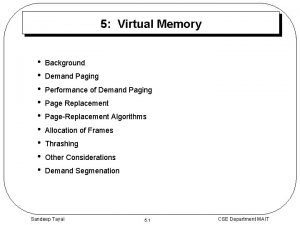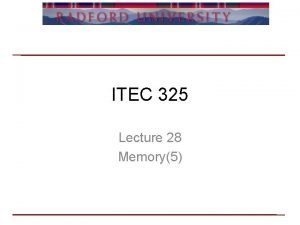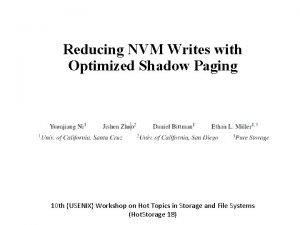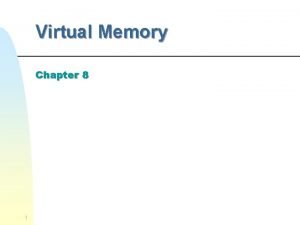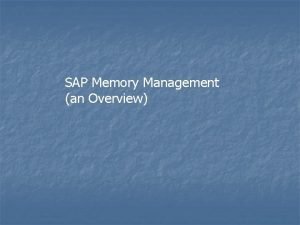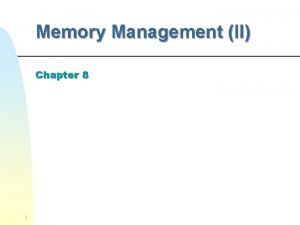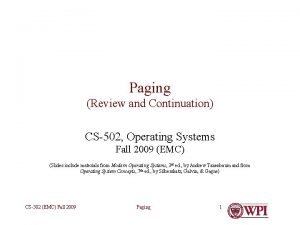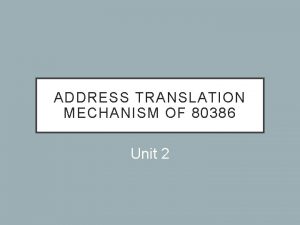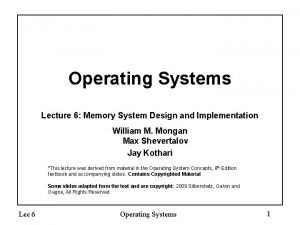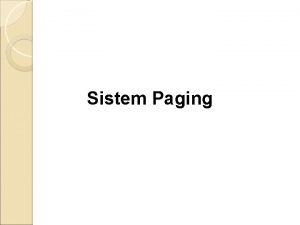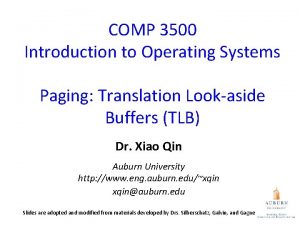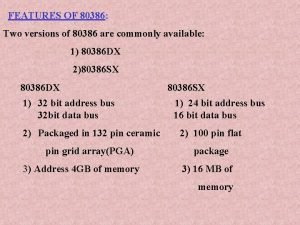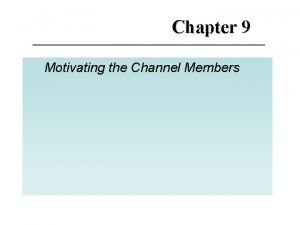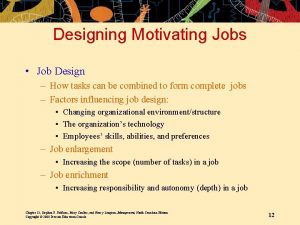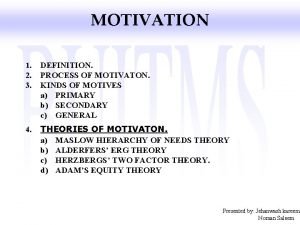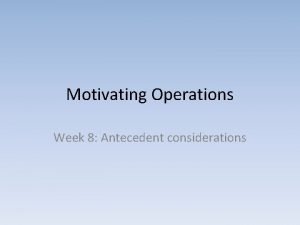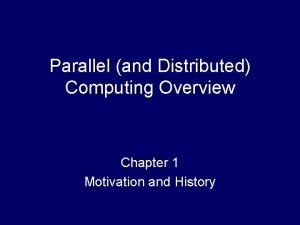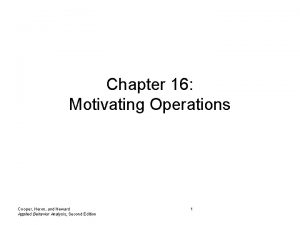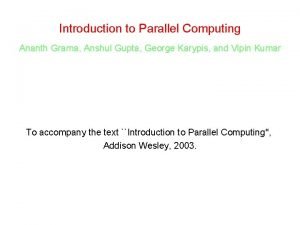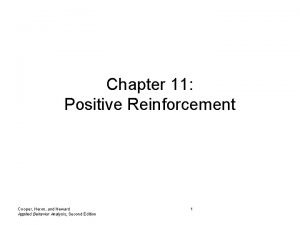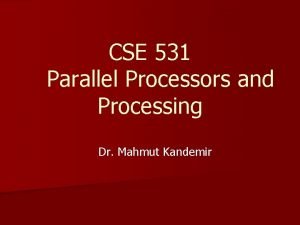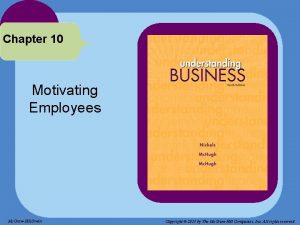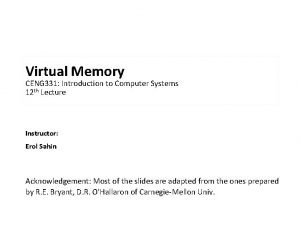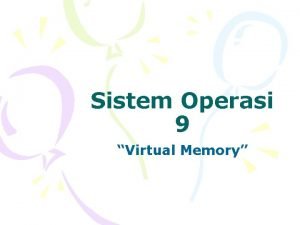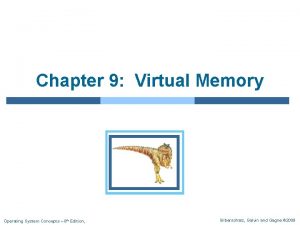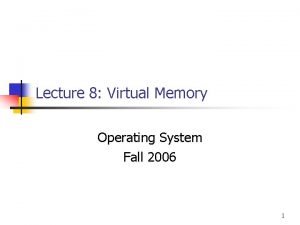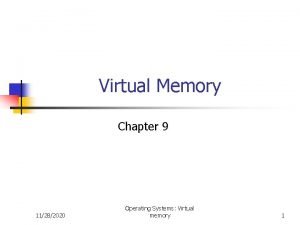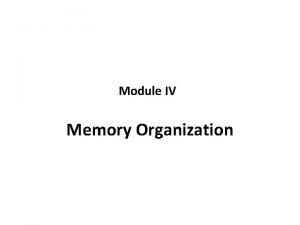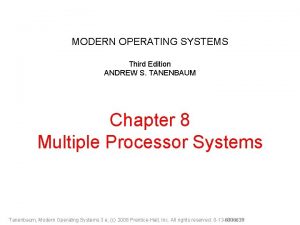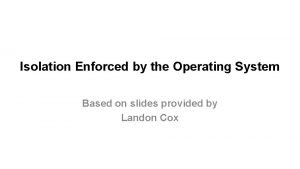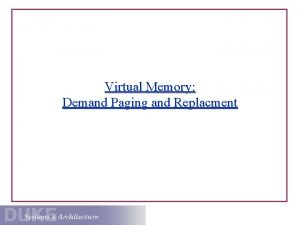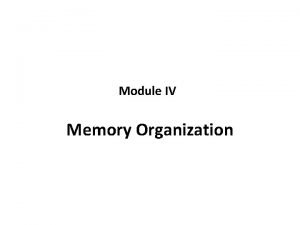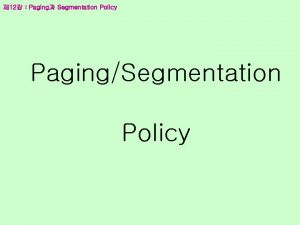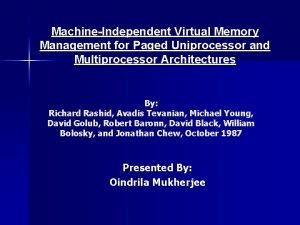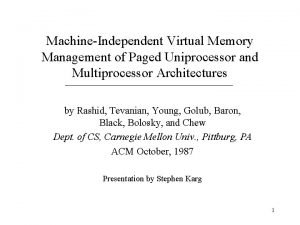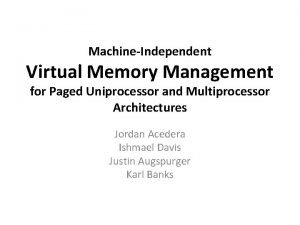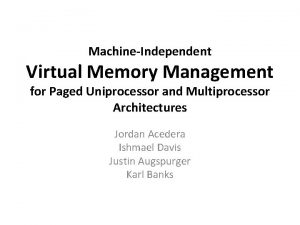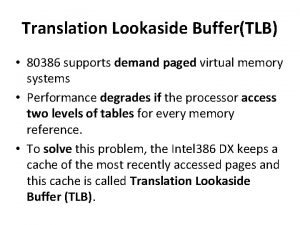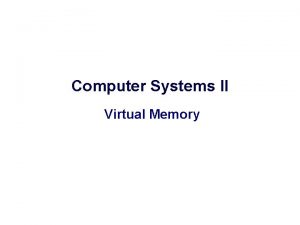Demand Paged Virtual Memory Motivating demand paging virtual






























































































- Slides: 94

Demand Paged Virtual Memory Motivating demand paging virtual memory n How demand paging virtual memory works n Issues in demand paging virtual memry n Page replace algorithms n

Up to this point… n We assume that a process needs to load all of its address space before running q q q e. g. , 0 x 0 to 0 xffff What do those translation schemes do? Memory abstraction is not perfect. n n Logical memory must be less than physical memory. Observation: 90% of time on 10% of code q q Loading the whole program is a waste. Demand paging virtual memory resolves this problem.

Demand Paging n Demand paging: allows pages that are referenced actively to reside in memory q Remaining pages stay on disk (swap space) q Advantages: n Truly decouples physical memory and logical memory. q n n n Provides the illusion of infinite physical memory. Each program takes less physical memory. Less I/O when swapping processes Fast fork();

Demand Paging: how it works? n n The process address space (image) is always in swap space (on disk). The page table entry (in memory) has three states: q q Valid with the page physical address Invalid with the address in the swap space n q n Valid page, but not currently in memory Invalid (truly invalid page) When a memory access is attempted: q q q Valid page physical address, normal access Invalid with the address in the swap space: page fault interrupt, which will bring in the page. Invalid, error

Address on swap space Truly invalid

Page Fault n n Hardware trap OS performs the following steps while running other processes q q q Choose a page (to be replaced) If the page has been modified, write its contents to disk Change the corresponding page table entry and TLB entry Load new page into memory from disk Update page table entry Restart the instruction

Challenge: Transparent Page Faults n Transparency q q A process should not do anything extra for the page faults (OS and the hardware should do everything). Why is it hard? n n Page fault interrupt is different from a typical interrupt! Page fault could happen in the middle of an instruction.

More on Transparent Page Faults n An instruction may have side effects q Hardware needs to either unwind or finish off those side effects ld r 1, x // page fault

More on Transparent Page Faults n Hardware designers need to understand virtual memory q q Unwinding instructions not always possible Example: block transfer instruction source begin block trans dest begin dest end source end

Challenge: Performance n Let p be the probability of page fault: q q q Ave. time = (1 -p) * memory time + p * page fault time Memory time: 10 ns to 200 ns Page fault time: disk access, context switching, etc n q In milliseconds Assuming: memory time = 200 ns, page fault time = 8 millisecond, p = 0. 1% n n n Ave time = 99. 9% * 200 + 0. 1% * 8000000 = 8200 Performance with demand paging is 41 times worse than the performance without demand paging!!! Is it still worth doing? Condition? ? ?

Page Replacement Policies (algorithms) n Random replacement: replace a random page + Easy to implement in hardware (e. g. , TLB) - May toss out useful pages n First in, first out (FIFO): toss out the oldest page + Fair for all pages - May toss out pages that are heavily used

More Page Replacement Policies n Optimal (MIN): replaces the page that will not be used for the longest time + Optimal - Does not know the future n Least-recently used (LRU): replaces the page that has not been used for the longest time + Good if past use predicts future use - Tricky to implement efficiently

More Page Replacement Policies n Least frequently used (LFU): replaces the page that is used least often Tracks usage count of pages + Good if past use predicts future use - Difficult to replace pages with high counts q

Example n A process makes references to 4 pages: A, B, E, and R q n Reference stream: BEERBAREBEAR Physical memory size: 3 pages

FIFO Memory page 1 2 3 B E E R B A R E B E A R B

FIFO Memory page 1 2 3 B E E R B A R E B E A R B E

FIFO Memory page 1 2 3 B E E R B A R E B E A R B E *

FIFO Memory page 1 2 3 B E E R B A R E B E A R B E * R

FIFO Memory page 1 2 3 B E E R B A R E B E A R B * E * R

FIFO Memory page 1 2 3 B E E R B A R E B E A R B * E * R

FIFO Memory page 1 2 3 B E E R B A R E B E A R B * A E * R

FIFO Memory page 1 2 3 B E E R B A R E B E A R B * A E * R *

FIFO Memory page 1 2 3 B E E R B A R E B E A R B * A E * * R *

FIFO Memory page 1 2 3 B E E R B A R E B E A R B * A E * * R *

FIFO Memory page 1 2 3 B E E R B A R E B E A R B * A E * * B R *

FIFO Memory page 1 2 3 B E E R B A R E B E A R B * A E * * B R *

FIFO Memory page 1 2 3 B E E R B A R E B E A R B * A E * * B R * E

FIFO Memory page 1 2 3 B E E R B A R E B E A R B * A * E * * B R * E

FIFO Memory page 1 2 3 B E E R B A R E B E A R B * A * E * * B R * E

FIFO Memory page 1 2 3 B E E R B A R E B E A R B * A * R E * * B R * E

FIFO n 7 page faults Memory page 1 2 3 B E E R B A R E B E A R B * A * R E * * B R * E

FIFO n 4 compulsory cache misses Memory page 1 2 3 B E E R B A R E B E A R B * A * R E * * B R * E

MIN Memory page 1 2 3 B E E R B A R E B E A R B E * R

MIN Memory page 1 2 3 B E E R B A R E B E A R B * E * R

MIN Memory page 1 2 3 B E E R B A R E B E A R B * E * R

MIN Memory page 1 2 3 B E E R B A R E B E A R B * A E * R

MIN Memory page 1 2 3 B E E R B A R E B E A R B * A E * R *

MIN Memory page 1 2 3 B E E R B A R E B E A R B * A E * * R *

MIN Memory page 1 2 3 B E E R B A R E B E A R B * A E * * R *

MIN Memory page 1 2 3 B E E R B A R E B E A R B * A E * * R * B

MIN Memory page 1 2 3 B E E R B A R E B E A R B * A E * * R * * B

MIN Memory page 1 2 3 B E E R B A R E B E A R B * A * E * * R * * B

MIN Memory page 1 2 3 B E E R B A R E B E A R B * A * R E * * R * * B

MIN n 6 page faults Memory page 1 2 3 B E E R B A R E B E A R B * A * R E * * R * * B

LRU Memory page 1 2 3 B E E R B A R E B E A R B E * R

LRU Memory page 1 2 3 B E E R B A R E B E A R B * E * R

LRU Memory page 1 2 3 B E E R B A R E B E A R B * E * R

LRU Memory page 1 2 3 B E E R B A R E B E A R B * E * A R

LRU Memory page 1 2 3 B E E R B A R E B E A R B * E * A R *

LRU Memory page 1 2 3 B E E R B A R E B E A R B * E * A R *

LRU Memory page 1 2 3 B E E R B A R E B E A R B * E A R *

LRU Memory page 1 2 3 B E E R B A R E B E A R B * E A R *

LRU Memory page 1 2 3 B E E R B A R E B E A R B *

LRU Memory page 1 2 3 B E E R B A R E B E A R B * E A R * B *

LRU Memory page 1 2 3 B E E R B A R E B E A R B * E A R * B *

LRU Memory page 1 2 3 B E E R B A R E B E A R B * E A R * B * A

LRU Memory page 1 2 3 B E E R B A R E B E A R B * E A R * B * A

LRU Memory page 1 2 3 B E E R B A R E B E A R B * E A R * B * R A

LRU n 8 page faults Memory page 1 2 3 B E E R B A R E B E A R B * E A R * B * R A

LFU Memory page 1 2 3 B E E R B A R E B E A R B

LFU Memory page 1 2 3 B E E R B A R E B E A R B E

LFU Memory page 1 2 3 B E E R B A R E B E A R B E 2

LFU Memory page 1 2 3 B E E R B A R E B E A R B E 2 R

LFU Memory page 1 2 3 B E E R B A R E B E A R B 2 E 2 R

LFU Memory page 1 2 3 B E E R B A R E B E A R B 2 E 2 R A

LFU Memory page 1 2 3 B E E R B A R E B E A R B 2 E 2 R A R

LFU Memory page 1 2 3 B E E R B A R E B E A R B 2 E 2 3 R A R

LFU Memory page 1 2 3 B E E R B A R E B E A R B 2 3 E 2 3 R A R

LFU Memory page 1 2 3 B E E R B A R E B E A R B 2 3 E 2 3 R A R 4

LFU Memory page 1 2 3 B E E R B A R E B E A R B 2 3 E 2 3 R A R 4 A

LFU Memory page 1 2 3 B E E R B A R E B E A R B 2 3 E 2 3 R A R 4 A R

LFU n 7 page faults Memory page 1 2 3 B E E R B A R E B E A R B 2 3 E 2 3 R A R 4 A R

Does adding RAM always reduce misses? n Yes for LRU and MIN q n Memory content of X pages X + 1 pages No for FIFO q q Due to modulo math Belady’s anomaly: getting more page faults by increasing the memory size

Belady’s Anomaly n 9 page faults Memory page 1 2 3 A B C D A B E A B C D E A D B E A C * * B C * D

Belady’s Anomaly n 10 page faults Memory page 1 2 3 4 A B C D A B E A B C D E A * B E * C D A E B D C

Implementing LRU n Perfect LRU requires a timestamp on each reference to a cache page q n Too expensive Common practice q Approximate the LRU behavior

Clock Algorithm n n Replaces an old page, but not the oldest page Arranges physical pages in a circle q n With a clock hand Each page has a used bit q q Set to 1 on reference On page fault, sweep the clock hand n n If the used bit == 1, set it to 0 If the used bit == 0, pick the page for replacement

Clock Algorithm 0 0 1 0 1 0

Clock Algorithm 0 0 1 0

Clock Algorithm 0 0 1 0

Clock Algorithm 0 0 1 0 0 0

Clock Algorithm 0 0 1 0 0 0

Clock Algorithm 0 0 1 0 0 0 replace

Clock Algorithm 0 0 1

Clock Algorithm n The clock hand cannot sweep indefinitely q n Slow moving hand q n Each bit is eventually cleared Few page faults Quick moving hand q Many page faults

Nth Chance Algorithm n A variant of clocking algorithm q q q A page has to be swept N times before being replaced N , Nth Chance Algorithm LRU Common implementation n n N = 2 for modified pages N = 1 for unmodified pages

States for a Page Table Entry n n Used bit: set when a page is referenced; cleared by the clock algorithm Modified bit: set when a page is modified; cleared when a page is written to disk Valid bit: set when a program can legitimately use this entry Read-only: set for a program to read the page, but not to modify it (e. g. , code pages)

Thrashing n Occurs when the memory is overcommitted q n Pages are still needed are tossed out Example q q q A process needs 50 memory pages A machine has only 40 memory pages Need to constantly move pages between memory and disk

Thrashing Avoidance n Programs should minimize the maximum memory requirement at a given time q n e. g. , matrix multiplications can be broken into submatrix multiplications OS figures out the memory needed for each process q Runs only the computations that can fit in RAM

Working Set n A set of pages that was referenced in the previous T seconds q n T , working set size of the entire process Observation q Beyond a certain threshold, more memory only slightly reduces the number of page faults

Working Set n LRU, 3 memory pages, 12 page faults Memory page 1 2 3 A B C D E F G H A D B C A C F D B G E H

Working Set n LRU, 4 memory pages, 8 page faults Memory page 1 2 3 4 A B C D E F G H A * B E * C F * D G * H

Working Set n LRU, 5 memory pages, 8 page faults Memory page 1 2 3 4 5 A B C D E F G H A * B F * C G * D H * E

Global and Local Replacement Policies n Global replacement policy: all pages are in a single pool (e. g. , UNIX) q One process needs more memory n Grabs memory from another process that needs less + Flexible - One process can drag down the entire system n Per-process replacement policy: each process has its own pool of pages
 Demand paging in virtual memory
Demand paging in virtual memory Weve requiring
Weve requiring Memory paging
Memory paging Virtual memory
Virtual memory Demand paging in virtual memory
Demand paging in virtual memory Demand paged memory allocation
Demand paged memory allocation Demand paged memory allocation
Demand paged memory allocation Jihad
Jihad Performance of demand paging
Performance of demand paging Demand paging
Demand paging Performance of demand paging
Performance of demand paging Virtual memory
Virtual memory Virtual memory in memory hierarchy consists of
Virtual memory in memory hierarchy consists of Paging mechanism in 80386
Paging mechanism in 80386 Paging in lte
Paging in lte Shadow paging recovery technique
Shadow paging recovery technique Tlb paging
Tlb paging Paging simulation
Paging simulation Shadow paging
Shadow paging What are the characteristics of paging ?
What are the characteristics of paging ? Facebook graph api paging
Facebook graph api paging Paging in
Paging in Paging with segmentation
Paging with segmentation Ip based paging system
Ip based paging system Em/initial_size_mb
Em/initial_size_mb Multilevel paging in os
Multilevel paging in os Comp3500
Comp3500 Paging
Paging Page translation in 80386
Page translation in 80386 Paging in os
Paging in os Komponen sistem paging
Komponen sistem paging Contoh paging
Contoh paging Page table
Page table Pong paging
Pong paging Umhs paging
Umhs paging Mobile communication
Mobile communication Operating modes of 80386
Operating modes of 80386 Long term memory vs short term memory
Long term memory vs short term memory Which memory is the actual working memory?
Which memory is the actual working memory? Internal memory and external memory
Internal memory and external memory Eidetic memory vs iconic memory
Eidetic memory vs iconic memory Semantic features definition
Semantic features definition Primary memory and secondary memory
Primary memory and secondary memory Implicit memory
Implicit memory Shared memory vs distributed memory
Shared memory vs distributed memory Logical versus physical address space
Logical versus physical address space Motivating yourself and others
Motivating yourself and others Motivating channel members
Motivating channel members Designing motivating jobs
Designing motivating jobs Want-satisfaction chain examples
Want-satisfaction chain examples Chapter 10 motivating and satisfying employees and teams
Chapter 10 motivating and satisfying employees and teams Motivating operations definition
Motivating operations definition Motivating parallelism
Motivating parallelism Motivating and satisfying employees and teams
Motivating and satisfying employees and teams Chapter 10 motivating employees
Chapter 10 motivating employees Inventory of good learner repertoires
Inventory of good learner repertoires Motivating and satisfying employees and teams
Motivating and satisfying employees and teams Planning and staffing
Planning and staffing Motivating operations examples
Motivating operations examples Palatable
Palatable Motivating people for total quality
Motivating people for total quality Sales force motivation theories
Sales force motivation theories Motivating students to learn english
Motivating students to learn english Copyright
Copyright Good morning again
Good morning again Introduction to parallel computing ananth grama
Introduction to parallel computing ananth grama Motivating software engineers
Motivating software engineers Cooper heron heward
Cooper heron heward Chapter 10 motivating employees
Chapter 10 motivating employees Process of controling
Process of controling Methods of sales force motivation
Methods of sales force motivation Exploitative authoritative example
Exploitative authoritative example Language focus
Language focus Motivating parallelism
Motivating parallelism Motivating employees without money
Motivating employees without money Motivating forces for exploration
Motivating forces for exploration Motivating and satisfying employees and teams
Motivating and satisfying employees and teams Chapter 10 motivating employees
Chapter 10 motivating employees Motivating example
Motivating example Virtual memory
Virtual memory Implementasi virtual memory
Implementasi virtual memory Apa karakteristik dari memori virtual?
Apa karakteristik dari memori virtual? Virtual memory is commonly implemented by
Virtual memory is commonly implemented by Dram memory mapping
Dram memory mapping 4 virtual
4 virtual Advantage
Advantage Virtual memory address translation
Virtual memory address translation Dram memory mapping
Dram memory mapping Kai hierarchy
Kai hierarchy Virtual memory os
Virtual memory os Virtual memory organization
Virtual memory organization Shared virtual memory
Shared virtual memory Virtual memory
Virtual memory Virtual memory os
Virtual memory os Slab is one or more physically contiguous frames.
Slab is one or more physically contiguous frames.
